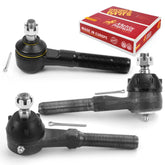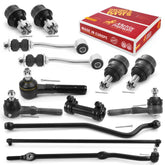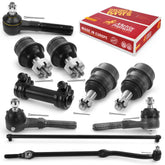What You Need to Know About Electric Vehicles and Aftermarket Solutions For Them

The number of electric vehicles on the road is increasing daily. For the most part, an EV's suspension can resemble an ICE's. The same factors still matter, such as ride quality, handling, and comfort, and these factors are independent of the motor type being used.
The change is happening so quickly that some people haven't had the time to digest the idea. If you are one of those folks, you shouldn't worry. We will tell you all there is to know about electric vehicles and the scope of aftermarket solutions for such automobiles.
Types of EVs
The moniker 'electric vehicle' covers all types of EVs. We have PHEVs, BEVs, and HEVs.
What's the difference between the three?
Let's find out!
BEV (Fully Electric)
Battery Electric Vehicle (BEV) is an EV that extracts power directly from the onboard battery. No engine is involved, meaning there is no need for a transmission, exhaust, or differential. You charge the battery, and that, in turn, powers the motor to put the wheels in motion. It is a unique system that is getting a lot of traction nowadays.
Driving a BEV is a unique experience because it does not react like a conventional vehicle. The
acceleration is instant, and the effect of coasting is different too. When you remove your foot from the pedal, the motor stops transferring power immediately, and the retardation is much faster than in a traditional car.
Moreover, the design changes in a BEV mean the battery components can be spread over evenly throughout the car, resulting in a much more balanced drive.
PHEV (Plug-in Hybrid)
If you are skeptical about stepping into the world of fully electric vehicles, you might love to try a PHEV. Plug-in Hybrids (PHEVs) have a medium-sized battery inside, accompanied by an internal combustion engine. The package gives you the security of an engine coupled with the efficiency and environment-friendly nature of a battery-powered motor.
In other words, a PHEV gives you the best of both worlds without risking performance or harming the environment too much. But the drawbacks, although few, are worth noticing. A car with a battery, motor, and engine is heavy and not evenly balanced. You must sacrifice ride height, increase the center of gravity and lose grip. You must plug the car into a charger to recharge the depleted battery.
The suspension requirements for PHEVs are also different. The system is overall a bit sturdier and stiffer than you would find on a regular car.
HEV (Hybrid)
The first step up the ladder from a conventional ICE-powered vehicle is an HEV (hybrid). A hybrid will give you a taste of the impressive mileage you can get from PHEVs and BEVs.
However, the engine still takes precedence in this kind of setup, and the hybrid system is only
there to give the car a small boost in terms of impressive fuel economy. HEVs are the stepping stone through which you can enter the world of electric vehicles. Once you are comfortable with an HEV, you can step up to a PHEV and finally to a BEV.
HEVs are also called self-charging hybrids because you don't need to charge them using an external power source. The car uses regenerative braking technology to convert the energy from braking into kinetic energy for later.
Difference Between EVs and Conventional Vehicles Suspension & Chassis Parts
Now that you know the different EV types, it is time to look at the difference between the chassis
and suspension of an EV and a regular car.
Little do people know, the design of a BEV and an ICE-powered vehicle varies quite a lot. The components look pretty much the same, but the position of some suspension components is different, and the chassis is designed differently.
The Steering Rack
A good example is the steering rack and its location in an EV and conventional car. The engine in a conventional vehicle takes up too much place, and there is often no space to place the steering rack other than at the back of the engine bay.
However, the steering rack usually comes in front of the wheel center in an electric vehicle. There is no engine, and the battery doesn't take up too much space in that area. As a result, the rack is placed in the optimal position.
You can look at some mid-engine cars like the famous Porsche 911, and you will find that the steering rack is positioned in front of the wheel center.
Double Wishbone Suspension
Another thing electric vehicles allow is the inclusion of double wishbone suspension. The latter is one of the most advanced suspension systems developed by engineers. But car manufacturers can hardly use them owing to limited space.
The front end of the BEV has ample space to accommodate double wishbone suspension.
However, the opposite is true for the suspension in the back. Some electric vehicles have big batteries at the back, which creates a challenge for engineers to pack the right suspension. So, there is some give and take in this department. If you get some freedom, there is also a risk of some restrictions in the design procedure.
Vehicle Weight
The extra weight of an EV battery puts pressure on the suspension components. Therefore, the suspension is designed to have more travel than usual. As a result, it can absorb much more force. The springs and struts are also built with solid materials to withstand the pressure of the impacts.
Absence of a Live Axle
Most modern EVs have no live axle. They do not have a driveshaft; hence there is no need for a live axle to distribute power to the wheels. The battery is connected directly to the motors, removing any need for a live axle.
That is a good thing for drive stability and handling. However, in the absence of a live axle, you must give the entire rear suspension a new home. Traditional cars have struts attached to the live axle, which joins with the chassis. If there is no beam axle, where does the suspension go? Well, the answer is independent suspension attached directly to the chassis.
Are EV Repairs Different?
EVs' main maintenance and repair costs are typically lower than those of conventional internal combustion engines. Unlike conventional cars, EVs don't need oil changes, spark plug replacements, timing belt replacements, fuel filters, differential and transmission fluid, etc. However, most EVs and traditional vehicles' maintenance procedures are the same when it comes to steering and suspension parts. Chassis parts have always been and will always be subject to failure over time, creating an ongoing need for replacement parts.
The positioning of these parts might be different, but nothing is out of the ordinary between the two. Fortunately, you can learn the component's location and how to repair them by using a service manual. However, you have to take care of a few things when doing repairs in an EV.
Not everyone is capable of handling batteries, as they are highly explosive. You have to be a certified electric vehicle technician to handle such cars. Otherwise, you would be putting your and other people's lives at stake. That also means you may not be able to undertake any DIY on your EV before you get the proper training.
As electric vehicles age, one's capacity to supply in the EV market will depend on knowledge, production capacity, and the availability of the required tools and aftermarket parts.
We believe it is essential to comprehend the unique qualities and challenges of EV chassis in terms of design, weight, torque, and performance characteristics to offer the best aftermarket component choices and excel in the EV market.
Aftermarket Solutions
If you feel your EV isn't giving you the handling and grip you require, you can make some tweaks by opting for aftermarket parts. Metrix Premium makes aftermarket suspension for all kinds of modern EVs. It doesn't matter if you have a Ford, Tesla, Volkswagen, Nissan, BMW, or Mercedes. Metrix Premium has suspension solutions for all such vehicles and more.









